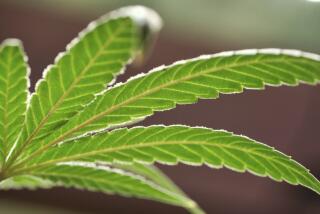Pot’s Rise Reported in Young Arrestees
- Share via
While marijuana use during the 1990s held steady in the nation’s general population, its popularity among 18- to 20-year-olds arrested for crimes soared and is now epidemic, according to a report released Friday by the U.S. Department of Justice.
Moreover, the study of 23 cities, including Los Angeles, found that as marijuana use grew, crack and heroin use declined significantly, raising questions about the long-debated inevitability that marijuana use leads to harder drugs.
“I think the findings are powerfully significant,” said the study’s co-author, Andrew Golub, a senior researcher at the National Development and Research Institute, a New York-based private, nonprofit foundation.
“Fifteen years ago, we documented that the use of cocaine, particularly crack cocaine, was rampant among arrestees. Five years ago, we documented that crack was declining,” Golub said.
“What we see today is that the drug of choice among arrestees is marijuana and that it is not serving as a gateway to something else,” Golub said.
Nationally, the study found, the rate of 18- to 20-year-olds who tested positive for marijuana when arrested for any crime rose from 25% in 1991 to 57% in 1996. From 1996 to 1999, the study found, marijuana use among that age group rose to about 60% and remained at that percentage through 1999, the most recent year for which statistics were available.
The high percentage accounted for most of the increase reported among all adults, 18 years and older, who tested positive for marijuana after arrests in the 1990s, the study found. In that group, the study says, marijuana use went from about 20% of the arrested population in 1990 to about 37% from 1996 on.
By comparison, the rate of marijuana use in the nation’s general population has remained static at about 5% for more than a decade, according to the study.
“Marijuana appears to have become the drug of choice among youths coming of age in the 1990s who tend to get in trouble with the law, in the same way that crack had been the drug of choice previously,” the report says.
The research, Golub said, suggests that the spike in marijuana use is attributable to several factors, including its acceptance as a far less damaging alternative to harder narcotics.
“Many of these individuals have seen the devastation resulting from crack and heroin use, and they blame their parents’ experiences on their use of these drugs,” he said. “And this explains why for many of these youths, use of marijuana is perceived as an act of resilience” that is celebrated in everything from clothing to music.
“This is a social phenomenon,” Golub said. “These youths define marijuana as not a drug.”
“I would say that, generally, that’s true,” said Lawrence Gentile, who runs the nonprofit Behavioral Services Inc., one of the largest drug treatment programs in Los Angeles County.
“My perception is that these kids just see this as a recreational activity,” said Gentile, whose clinics and residential programs handle more than 5,000 clients a year, about a fourth of them ages 18 to 20. “They don’t see . . . a major issue with using marijuana.”
While the study found that marijuana use among arrested youths in Los Angeles may not have yet peaked as in other cities, the relative percentage (54%) was well below that of other cities such as Miami (66%), Atlanta (72%) and Chicago (75%).
But Los Angeles’ lower number may only reflect a separate drug trend: the West Coast prevalence of methamphetamines, according to researcher Golub.
A 1999 Department of Justice report, he said, found that 10% of Los Angeles arrestees of all ages tested positive for methamphetamines. The rate in New York City and other East Coast locations was less than 1%.
The study was funded by the National Institute of Justice and is part of a larger project funded by the Robert Wood Johnson Foundation.
More to Read
Sign up for Essential California
The most important California stories and recommendations in your inbox every morning.
You may occasionally receive promotional content from the Los Angeles Times.










